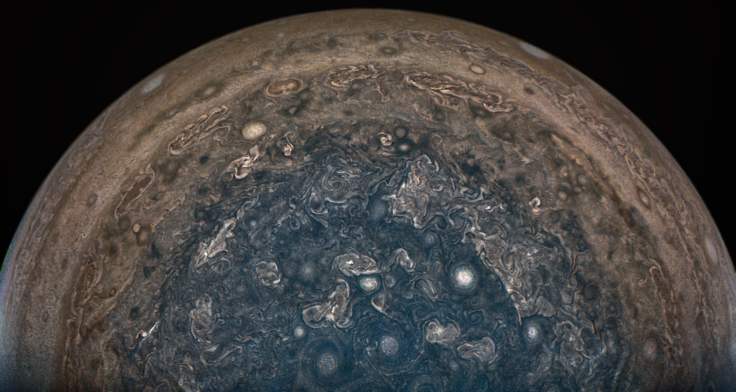NASA’s Juno To Stay In 53-Day Jupiter Orbit For Fifth Flyby, Avoiding Risky Engine Firing

For its fifth flyby of Jupiter, NASA’s Juno spacecraft will stay in its current 53-day long orbit around the gas giant, the space agency announced Friday. Earlier, NASA had planned to fire Juno’s engine, a risky maneuver that would have reduced the orbital period to 14 days.
The longer duration of the orbit will give Juno more time to explore the far reaches of space that are affected by the magnetic field of Jupiter, the biggest planet in our solar system. And the longer orbit will still keep the spacecraft at the same orbit as earlier flybys during the time of its closest approach — about 2,600 miles above the cloud tops of Jupiter’s atmosphere — allowing it to accomplish its science goals.
“Juno is healthy, its science instruments are fully operational, and the data and images we’ve received are nothing short of amazing. The decision to forego the burn is the right thing to do — preserving a valuable asset so that Juno can continue its exciting journey of discovery,” Thomas Zurbuchen, associate administrator for NASA’s Science Mission Directorate, said in a statement.
The Juno mission to study Jupiter has already made four flybys of the planet, and during each of them, it probes beneath the thick cloud cover to analyze the planet’s auroras to learn about how Jupiter formed, its structure — including whether it has a solid core — its atmosphere and magnetosphere.
According to the original plan for Juno — which has been orbiting Jupiter since July 4, 2016 — it would orbit the gas giant twice in 53-day cycles, and then switch to the shorter 14-day cycles. However, two helium check valves in the spacecraft’s main engine did not perform as expected in October, making it risky to fire the engine.
“During a thorough review, we looked at multiple scenarios that would place Juno in a shorter-period orbit, but there was concern that another main engine burn could result in a less-than-desirable orbit. The bottom line is a burn represented a risk to completion of Juno’s science objectives,” Rick Nybakken, Juno project manager at NASA’s Jet Propulsion Laboratory in Pasadena, California, said in the statement.
The longer orbital period will also reduce the radiation exposure to Juno, which NASA says is the main factor that will limit the spacecraft’s life.
Current budgetary allowance will keep Juno going till July 2018, for a total of 12 orbits.
© Copyright IBTimes 2024. All rights reserved.





















